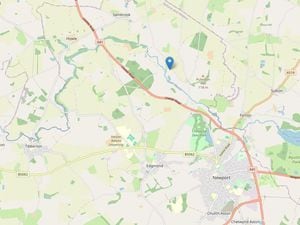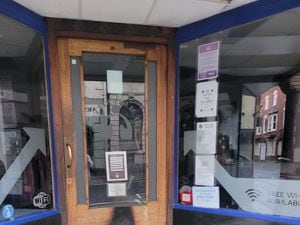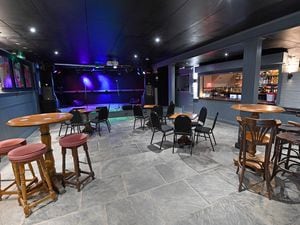University of Wolverhampton halfway to £250m funding goal
Geoff Layer's vision for Wolverhampton University sounds more like the mission statement of a high-flying business than a cathedral of learning.
"We're about strengthening the economy, growing the economy, creating jobs," says the go-getting vice chancellor, who is at the helm of a five-year project that will put the city and its university firmly at the centre of the Black Country's regeneration.
The ambitious £250 million programme to overhaul its buildings and facilities was launched last year and in the first 12 months has already secured almost half the funding. It is a question of when, not if, the rest will follow.
With a general election on the horizon and discussions emerging about the West Midlands Combined Authority, the university chiefs put their heads together this time last year.
Professor Layer said: "Things were going to happen. We'd had a period of reflection and in our strategy we'd talked about being an economic anchor regionally.
"Because our students go to work in the area, our vision was about boosting the economy in the area, upskilling the workforce, training the workforce of the future, helping them start up companies.
"So in March 2015 we decided to set a target of generating £250m over five years. The amount so far committed is just shy of £120m of which 60 per cent is cash the university has generated and 40 per cent has come from external funding. I think it's gone better than we had thought."

The money is being spent on a host of schemes, with a £65m chunk being poured into transforming the historic 12-acre former Springfield Brewery site that closed in the early 1990s.
The prize canalside location, derelict for so long, will be opened in phases, with the West Midlands Construction University Technical College the first to take in students this autumn. This will be followed by the Elite Centre for Manufacturing Skills next year, and the School of Architecture and the Built Environment in 2018. The entire site is expected to be fully operational by 2020.
In other developments, a £10m health college in West Bromwich, in the former Sandwell College building, opened in September. The university is also building a £25m science block and will fund a £4 million revamp of the food court at the University's Millennium City Building, as well as a makeover of the main courtyard area and better access to the back of the Wulfruna Building, in particular the newly-refurbished Chancellor's Hall.
In November a six-storey £20m business school, formally named the Lord Swraj Paul Building, opened its doors to students. More recently, in February, work started on the £10m Science, Technology and Prototyping Centre on land at the university's Science Park and last month the £500,000 transformation of The Feathers, a former match-day favourite of Wolves fans, into a new apprenticeship hub began.
And just last week the university announced it was spending £13m on upgrading digital learning technology for students. Some 700 computers will be replaced across the Wolverhampton and Walsall campuses with the latest machines, with plans to roll it out to Telford next year. And, beyond that, there are plans to use digital technology in a new way.

Among the innovations will be a virtual learning environment where notes can be uploaded and recordings of all lectures can be heard again. Goodbye old-school hand-outs, hello cloud storage.
In many areas, the university wants to reverse trends, says Professor Layer. "We're a region with a high proportion of adults without educational qualifications, so we have set up adult second-chance learning, to get them back into education and training. As a result, we're one of the few universities that has seen a growth in the number of post-25 learners."
Wolverhampton has also bucked the national decline since 2012 in part-time studying, which has fallen 40 per cent in England.
"This is partly because the way the fees are structured has changed and partly because the bulk of part-time students were from the public sector which has undergone a cull in staff numbers, so we've constructed a strategy where we take the courses to the places where people work rather than expecting them to come to us," says the vice chancellor.
The university has seen numbers growing since setting up in Stafford and Telford town centres and is now looking to do the same in other places. "We are a key agent of economic regeneration. We make sure the curricula is appropriate to that town, so IT is particularly important in Telford and military history in Stafford where there are hundreds of MoD staff back from Germany. We also provide telecommunications courses for the Signals Regiment."
New areas for the university include post-graduate chemical engineering provision. Geoff Layer says the engineering as a subject is being overhauled and is a big growth area for the university.
Some £4m is going into classrooms, a special laboratory for the teaching of psychology and special simulated hospital wards will be created for nursing students.
The Walsall campus has also had money spent on it with improved sports facilities, including the installation of FA-standard 4G pitches and a new access.
The university boasts that 78 per cent of their students find work within six months of graduating. And it is the first, if not the only, university in the West Midlands to be awarded by the Quality Assessment Agency for its teaching.
"What is really important in an area of high unemployment is giving our students the best possible learning environment and facilities so they can achieve at the very highest level and have the best start in life," says Geoff Layer.
He nods towards the art gallery across the road from his second-floor office. "This place was founded in 1827 as a Mechanics Institute, there's a plaque at the art gallery over there marking that.
"The idea back then was about developing the workforce, they wanted design in the finished product for industry. Even then, a high value side was put on having the best design, and we've never lost that tradition."





